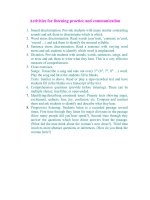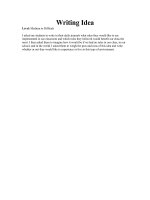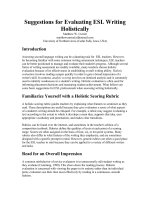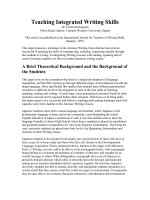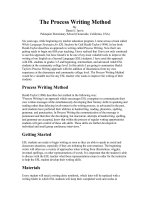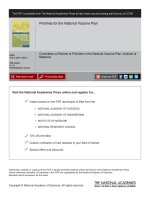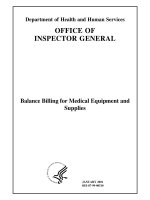Suggestions for Evaluating ESL Writing Holistically.doc
Bạn đang xem bản rút gọn của tài liệu. Xem và tải ngay bản đầy đủ của tài liệu tại đây (73.08 KB, 2 trang )
Suggestions for Evaluating ESL Writing
Holistically
Matthew W. Currier
matthewcurrier[at]hotmail.com
University of Northern Iowa (Cedar Falls, Iowa, USA)
Introduction
Assessing second language writing can be a daunting task for ESL teachers. However, by
becoming familiar with some common writing assessment techniques, ESL teachers can be
better positioned to manage and evaluate their student's progress. Although several forms
of writing assessment are readily available, many teachers choose holistic evaluation
because of its effectiveness in establishing overall writing ability. Holistic evaluation
involves reading a paper quickly in order to gain a broad impression of a writer's skill. In
contrast, analytic scoring involves an itemized analysis and is commonly used to identify
weaknesses in a student's writing. Holistic evaluation is often used for informing placement
decisions and measuring student achievement. What follows are some basic suggestions for
ESL professionals when assessing writing holistically.
Familiarize Yourself with a Holistic Scoring Rubric
A holistic scoring rubric guides teachers by explaining what features to scrutinize as they
read. These descriptions are useful because they give evaluators a sense of what aspects of
a student's writing should be critiqued. For example, a rubric may suggest evaluating a text
according to the extent to which it develops a main idea, supports that idea, uses
appropriate vocabulary and punctuation, and makes clear transitions.
Rubrics can be found over the internet, and sometimes in the teacher's edition of a
composition textbook. Rubrics define the qualities of texts at each point of a scoring range.
Scores are often assigned on the basis of four, six, or ten point systems. Many rubrics also
differ in what features of the writing they emphasize, and are sometimes designed with a
specific prompt in mind. However, generic rubrics are often a good place for the ESL
teacher to start because they can be applied to a variety of different writers and tasks.
Read for an Overall Impression
A common misbehavior of novice evaluators is to unnecessarily edit student writing as
they evaluate (Cumming, 1990). This slows down the reading process. Holistic evaluation
is concerned with viewing the paper in its entirety rather than its individual parts;
evaluators use their time most effectively by reading in a continuous, smooth fashion.
Keep the Writing Prompt in Mind as You Read
The nature of the task will dictate the style of discourse. If, for example, the task requires
students to argue a position, such as whether mass transportation is beneficial to society,
you would expect an essay to contain several main points with details and examples
supporting those points. If, on the other hand, the task requires students to explain a
moment that changed their life, you might expect less academic essay structures. Be aware
that a descriptive task, such as a student describing his or her country, may elicit a different
performance than a student explaining the role of pets in America, which is more an
expository writing task (e.g., Way, Joiner, & Seaman).
Know Your Students' Backgrounds
Writing clearly and adeptly is a learned skill that can be challenging for both native and
nonnative English speakers. ESL educators are aware that their students often have only
vaguely developed language skills and sometimes little or no writing skills. When teachers
read student texts, they should be aware that students may be transferring rhetorical
patterns from their first language to English. Such structures may be puzzling to the teacher
accustomed to Western rhetorical patterns but familiar to the ESL student, who may be
writing with previous notions of evaluative criteria in mind. This might be the case with a
student from Japan where teachers have been shown to value content, word choice, and
grammar rather than cohesion and coherence, which have been shown to be values of
American teachers (Connor-Linton, 1995). A general understanding of these differences
allows ESL educators to better understand their students.
Conclusion
By being aware of the aforementioned issues, ESL teachers can more effectively assess
their students' writing. Holistic evaluation is a useful tool that informs teachers and allows
them to more capably meet their students' needs. This enhances the educational process and
leads to both knowledgeable teachers and ESL writers.
